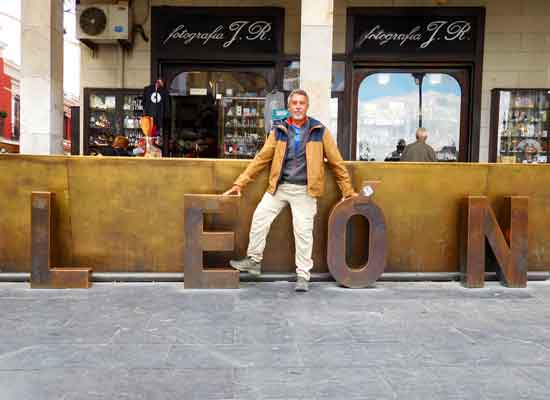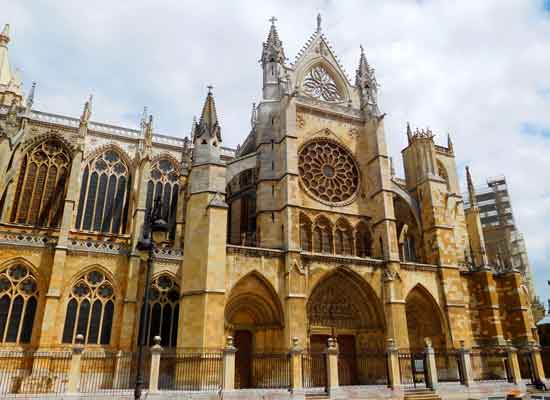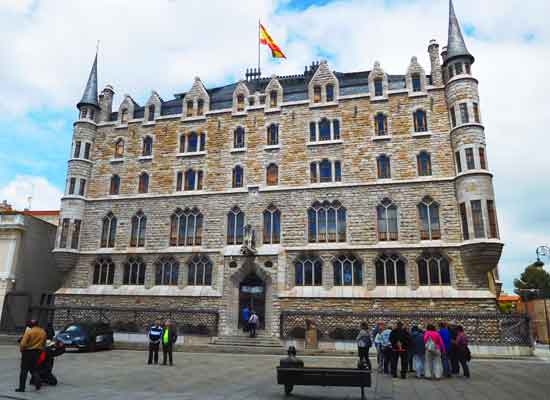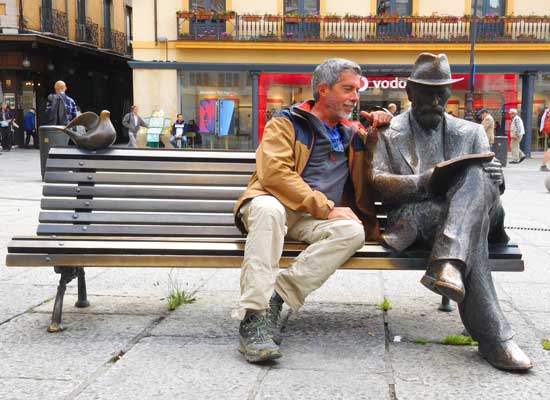Step by step along The Way of Saint James
From Puente Villarente to León
30 May 2018
Stage 20 – Km. 13

I’m not entirely sure why, but I always feel a special emotion when I arrive on foot in a big city. Just as it happened in Pamplona and Burgos, I imagine it will be the same today when I reach León.
This time, moreover, I’ll be transitioning to urban life after several days of walking through endless deserted plains.
Arriving in León can be seen as the end of the “mesetas” and, probably for this reason, the excitement of reaching a big city will be even stronger.
Today, I set off once again with Rocco, leaving the hostel in Puente Villarente at 6:30.
We have only thirteen kilometres ahead of us, and we estimate it will take about three hours to cover them.
Planning such a short stage was a deliberate choice: this way, we’ll reach León early enough to have a good part of the day to explore the city.
The landscape we pass through isn’t attractive at all, and it becomes even less so as we approach the outskirts of León.
It isn’t particularly cold, and although the sky is overcast, it doesn’t seem likely to rain. Large gaps in the clouds on the horizon give us hope for better weather.
As for the pain in my shins, I no longer know what to think or say: today, it’s noticeable right from the morning. Luckily, there aren’t many hours of walking ahead, and this thought alone gives me the strength to start another day on the path leading to Santiago de Compostela.
After the first hour of walking, we pass through the small village of Arcahueja.
We don’t stop, both because there’s no particular reason to do so and because we’re eager to reach the city as soon as possible.
It’s about quarter past eight when we reach the outskirts of León.
The multi-lane asphalt roads replace the silent plains of the “mesetas,” making me miss walking through the emptiness.

A temporary diversion from the usual route of The Way of Saint James forces us to follow an alternative path leading up to Alto del Portillo.
Although this detour lengthens our walk slightly, it also spares us from traversing busy road junctions at the city entrance and the anonymous suburban streets.
This variant takes us up a wooded hill, from the top of which (about 800 metres above sea level) we have a beautiful panoramic view of León.
In particular, we can make out the historic centre and the splendid cathedral with its towering spires.
Crossing the Puente Castro, a medieval stone bridge with ten arches over the Río Torío, marks our official entrance into the city.
From this point, we have just two kilometres left to reach the hostel.
At 9:50, having reached the Albergue Santa Maria de Carbajal, we can consider today’s short stage complete.
The hostel is located in the namesake Benedictine monastery, and the pilgrims are welcomed not only by the nuns but also by volunteer “hospitaleros.” These are laypeople who have previously walked The Way and know firsthand what those walking to Santiago de Compostela need.
Resting, showering, washing clothes, and eating are the basic necessities for any pilgrim, but those who arrive here also find the warmth of hospitality.
The volunteers at the hostel give back the same love they received when they themselves walked The Way.
– Anyone who has been a pilgrim knows how to treat pilgrims! –
We arrive slightly ahead of the hostel’s opening hours, so we have to wait about an hour before we can check in.
While waiting, we take the opportunity to rest, nibble, and drink something from the vending machines located at the monastery entrance.
As we wait, other pilgrims arrive, including Juanì and Anna. Like us, they also wait for the hostel to open, thus establishing an order of arrival.
While waiting, I take the opportunity to do some research online, hoping to find information that might help me deal with my physical problems.
As I’ve already said, – Searching on Google isn’t the same as consulting a real doctor. –
However, I don’t feel like spending the afternoon looking for a doctor instead of touring the beautiful city of León. Moreover, I imagine that, before prescribing any tests or medication, the specialist I consult would advise me to take a few days of complete rest—something I have no intention of considering as long as I can somehow continue my journey along The Way of Saint James.
I find several articles online describing symptoms similar to mine.
Shin pain is common among those who regularly engage in sports activities that put a strain on the legs, such as running and trekking.
The first suggestion offered is rest. – Obviously! –
I also read recommendations that immediately catch my attention: “lose weight if overweight” and “apply localized ice packs.”
I’ve never tried using cold therapy on the affected muscles, and the ointment I’ve been using so far produces heat. So, from now on, I’ll try cold instead of heat.
As for “losing weight,” I can say I’m not physically overweight. However, if I consider the nearly ten kilograms of backpack I carry on my shoulders every day, which also weighs on my legs, then I am indeed overloaded.
So, if the advice is to shed weight, I can immediately achieve this goal by shedding ten kilograms in one go.
– Starting tomorrow, and at least for a few days, I’ll be sending my backpack ahead via courier. –
It’s true! The “fundamentalism” of The Way demands that everyone carry their own load. I agree with this, but I prefer to allow myself this concession rather than stop for several days or even abandon the journey and return home.
Meanwhile, following advice from someone qualified, I also change the anti-inflammatory medication I’ve been taking for the past few days.
***
At exactly eleven o’clock, I am the first to be admitted to the hostel today.
After securing my bed and dropping off my backpack, I set out with Rocco to explore the city.
To reach the cathedral, which is just five hundred metres away from the Benedictine hostel as the crow flies, we walk through the intricate and fascinating Barrio Húmedo.
This area, part of the old medieval centre, is now the heart of León’s nightlife.
The narrow streets and small squares of the district are packed with bars, inexpensive restaurants, wine cellars, and “chigres.”
The latter are traditional establishments where cider is served.
This drink, typical of Asturias and made from fermented apples, is poured following the ritual of “escanciar.”
The cider is poured by skilled servers who hold the bottle high, with their right arm fully extended above their head, while the glass is held as low as possible with the left hand.
This gesture is not just for show; it enhances the cider’s flavour and aroma.


Wandering aimlessly, we end up in Plaza Mayor, where a bustling market is taking place, filled with stalls and people.
Flowers, fruits, and vegetables are the most colourful goods on display, but the square’s defining feature is the town hall building, a beautiful example of Baroque architecture.
It alone gives us a sense of León’s rich history and artistic heritage.
Continuing our city tour, we arrive at Plaza de la Regla, where the spectacular cathedral stands—the most famous monument in León.
Built in the 13th century, its architecture was inspired by the great French Gothic cathedrals.
Because of its elegance and beauty, it is nicknamed the “Pulchra Leonina,” which means “Beautiful Lioness” in Latin.
It’s just after noon, and the cathedral is closed for the moment.
We decide to postpone the visit to the interior until the afternoon. For now, we content ourselves with walking around the outside, admiring its splendidly decorated façades.
Like the cathedral, most businesses are closed at this hour for the lunch break.
So, adapting to the city’s rhythm, we first have a snack of tortilla and then return to the hostel for a short rest.
My break also includes starting a new treatment for my shins, using ice packs on the painful areas.
I immediately feel the soothing effect of the cold and keep the application going longer than recommended, hoping to speed up the recovery process.

At 16:30, we return to the city centre to visit the interior of Santa María de la Regla, the cathedral of León, which is dedicated to the Virgin Mary.
Entrance costs 6 Euros, including an audio guide, with no discounts for pilgrims.
From the moment we step into the impressive central nave, we are left in awe.
It’s impossible to summarize in a few lines the beauty of all the naves, chapels, and other remarkable features inside the cathedral.
For this reason, I’ll leave my readers to consult specialized guides for detailed descriptions.
I’ll just highlight one noteworthy feature—the colourful medieval stained-glass windows.
These windows are considered among the most beautiful in the world, depicting stories and images from the Old Testament.
They are the pride of the cathedral, covering nearly two thousand square metres.
The light filtering through them creates an enchanting atmosphere inside.
Guided by the audio descriptions, I spend almost two hours admiring the cathedral’s architectural and artistic treasures.


Outside the cathedral, I find Rocco again, as we inevitably lost each other during the visit.
We continue exploring León’s historic centre, walking down Calle Ancha until we reach Plaza San Marcelo.
In this square stands another monument of great historical interest, although it dates back only to 1892—Casa Botines, designed by Antoni Gaudí.
Commissioned by textile merchants, this building reflects the Catalan architect’s creative brilliance and imagination.
Gaudí combined modernist and medieval styles in a striking way.
The guided tour inside lasts an hour and a half, but since we want to see more of the city, we settle for exploring just the freely accessible ground floor.
In the square, directly in front of Casa Botines, a bench integrates with a bronze statue of Gaudí, depicted sitting and taking notes in a sketchbook.
– I can’t miss the chance to pose for a photo next to the great master! –
We spend the rest of the afternoon strolling around León’s lively city centre.
The streets are filled with people enjoying popular spots like the Ginger Bar, an old-fashioned venue located at the corner of Calle Ancha and Calle Cervantes.
Every now and then, we stop to chat with fellow pilgrims we meet along the way.
It feels almost like a “Stations of the Cross” procession—not just for the frequent stops but also for the stories of ailments caused by The Way that we exchange at each “station.”
On this note, we run into Giovanna from Sassari, whom we left in El Burgo Ranero two days ago in tears because of her blisters.
We left her crying, but now we find her smiling and determined to continue her journey to Santiago de Compostela.
She visited a hospital where her blisters were treated and replaced her trekking boots with technical sandals, following the advice of a knowledgeable shopkeeper.
We end our day with dinner at a restaurant next to the hostel.
From the “pilgrim’s menu,” I choose a hearty lentil soup, cod, and arroz con leche—a traditional Spanish dessert made with rice and milk.
Back at the hostel, I meet Salvador, my Spanish friend now living in Strasbourg.
We had lost track of each other after Burgos due to his ankle tendonitis.
I find him reborn and cheerful, having resolved his physical issues.
We’re both happy to see each other again, even though this will likely be our last meeting on The Way, as he plans to stay an extra day in León to visit relatives.
Unlike my usual routine, today I take a shower before bed.
Thanks to the short stage and cool weather, I managed to stay reasonably clean until the evening.
| © Aldo Lardizzone 2020 |  |
CREATIVE COMMONS |



